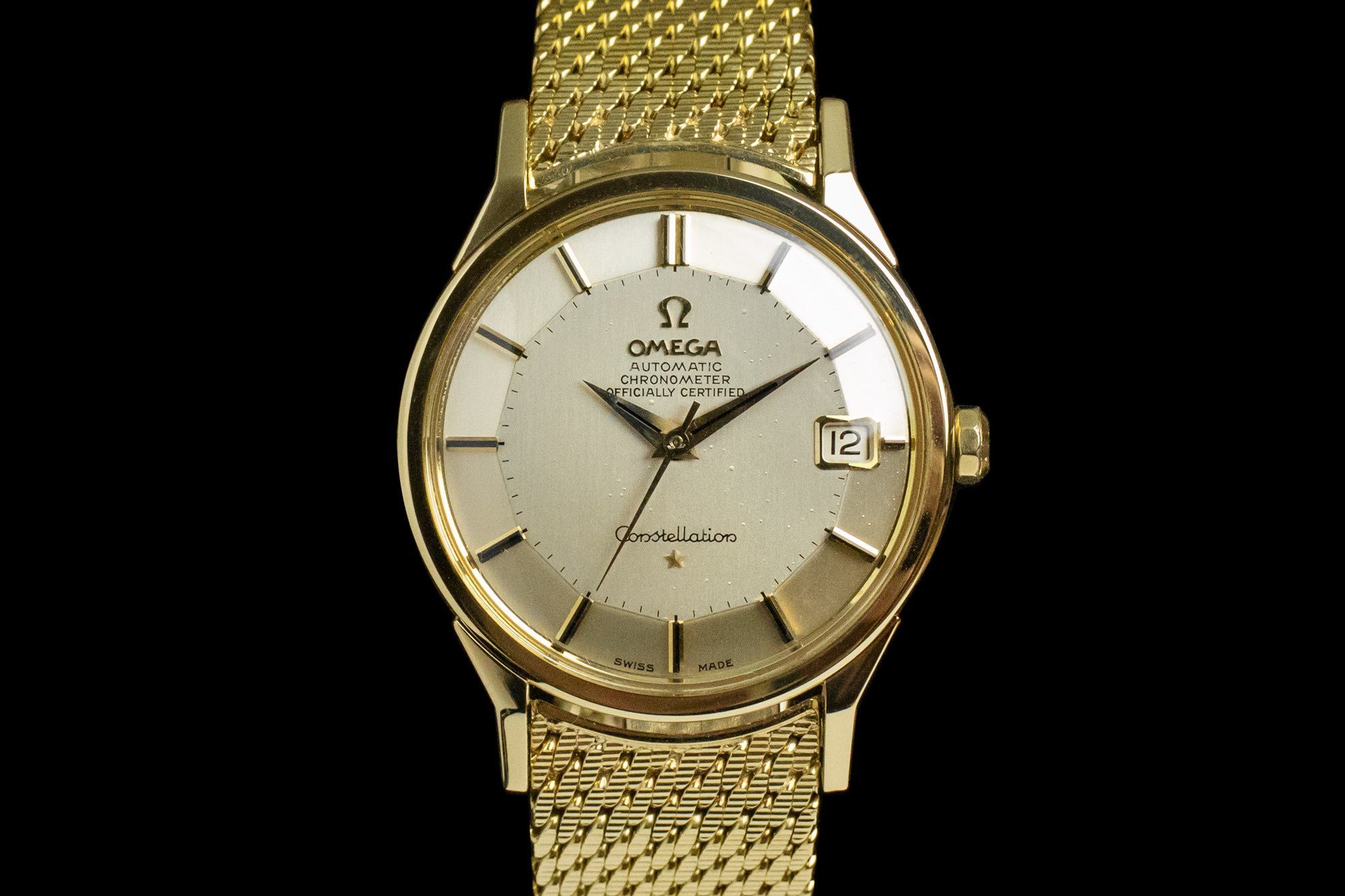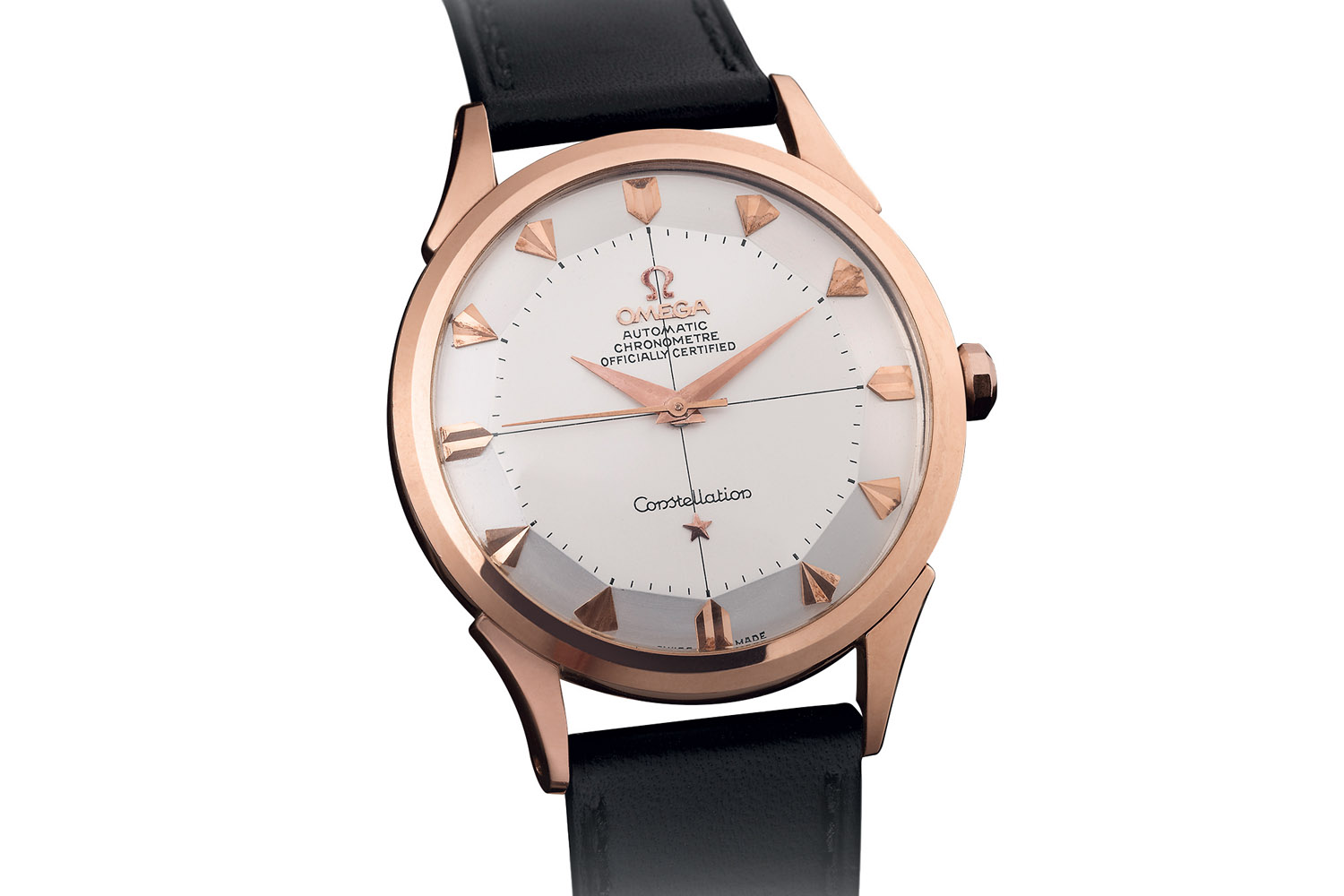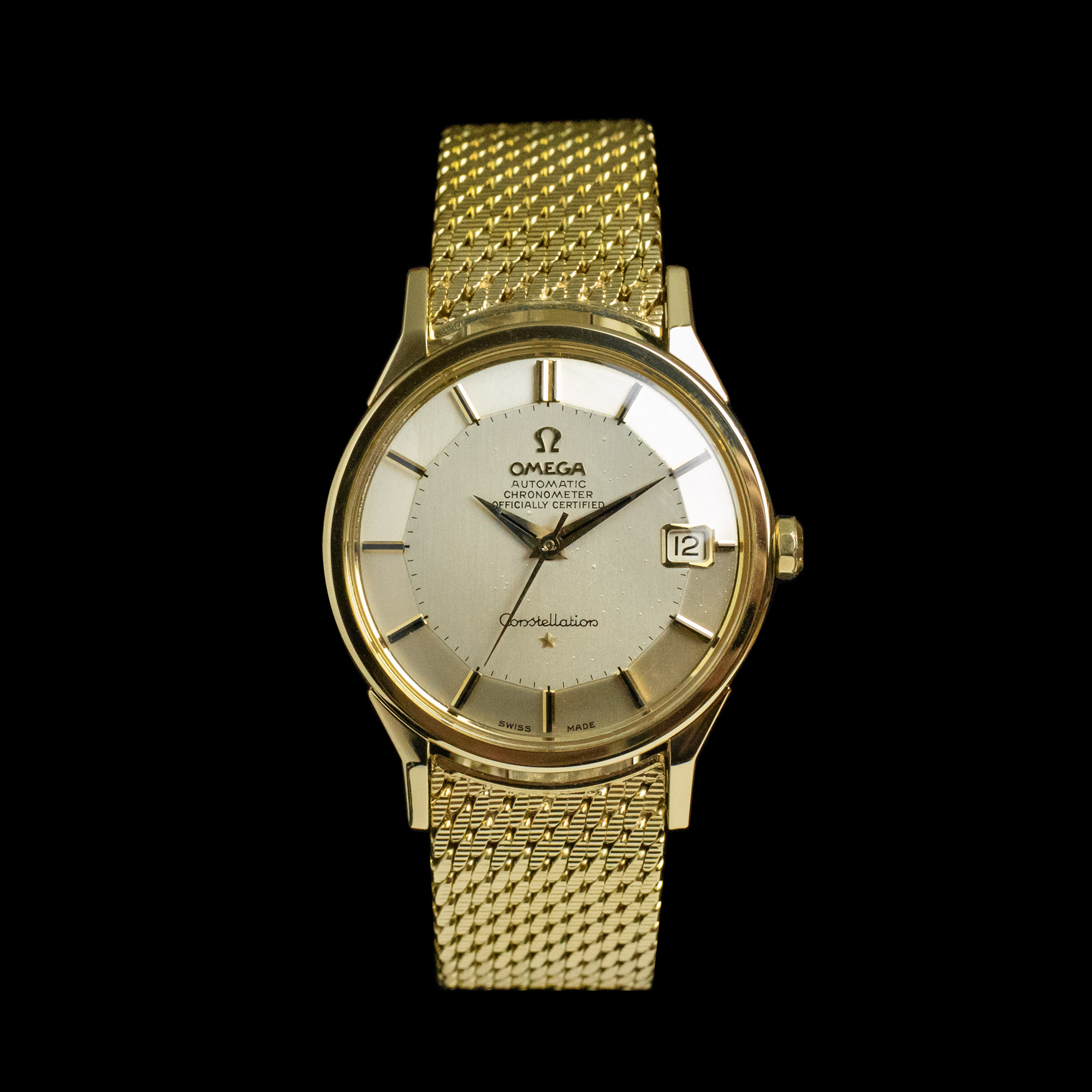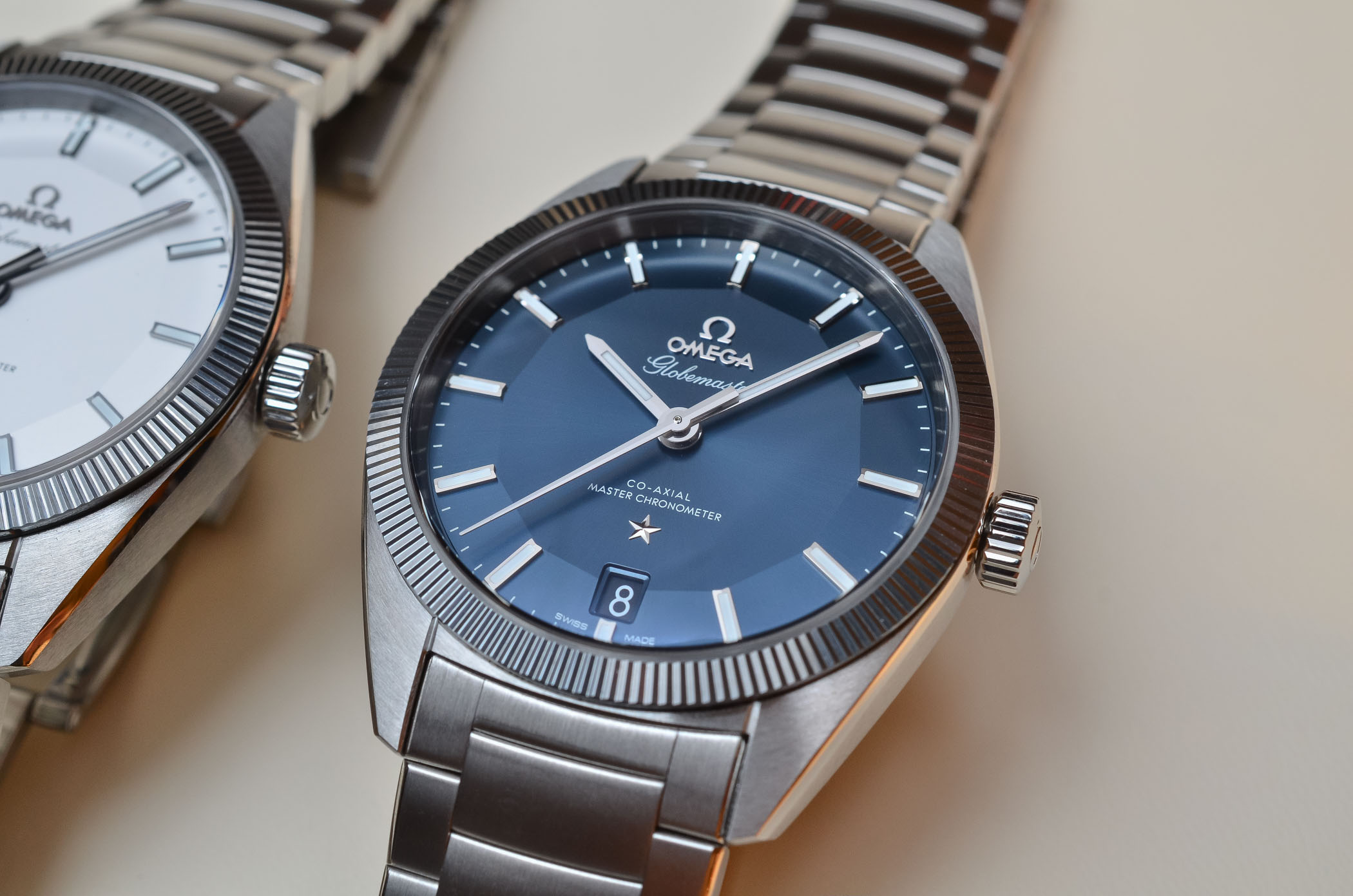The History of the Omega Constellation
The continuous evolution of an imperishable collection over six decades of life.

The Constellation family has been around for 66 years and is currently one of Omega’s oldest collections. What started out as a chronometer for men in 1952 has undergone countless aesthetic transformations, from the pie-pan dials of the 1950s to the ultra-thin quartz watches of the 1970s leading to the consolidation of the collection in 1982 with the Constellation Manhattan and its hallmark claws. Today many Constellation models are equipped with Master Chronometer movements respecting the original vocation of this family to combine luxury and precision. Let’s take a look at how the Constellation got its star power and its claws.
Born as a chronometer in 1952
To celebrate its 100th anniversary in 1948, Omega released the Centenary, its first limited-edition chronometer-certified wristwatch with an automatic movement. Given the positive reaction to this unrivalled combination of precision and practicality, Omega decided the time was ripe for a collection of automatic wristwatches with chronometry status.

In 1952, Omega unveiled the series-produced Constellation, a family of watches originally destined for men fitted with calibre 354. Two salient features distinguished the first members of the Constellation family: a star and the name of the watch above the 6 o’clock marker and a sealed caseback with a medallion featuring the Observatory of Geneva crowned by a constellation of eight stars. The image of the observatory was designed to evoke Omega’s exploits in chronometry and its world precision records set in 1933 and 1936 at Kew-Teddington.

The first models were fitted with calibres 351, 352, and 354 with bumper rotors and replaced four years later by calibres 500, 501, 505 and subsequently, in 1966 with calibre 561 for the date model, and eventually calibre 564. The early automatic bumper movements got their name from the slight thud the owner could perceive when the rotor hit a spring and bumped back. Unlike modern automatics that perform a full 360-degree spin, the rotor of these bumper movements moved back and forth at roughly 120 degrees ‘bumping off’ a pair of springs on the opposite sides of the watch…an effective way of accumulating kinetic energy invented by English watchmaker John Harwood in 1923.

Pie-Pan Dials
An unusual feature of many Constellation watches in the 1950s and 1960s was the domed dial, colloquially referred to as a pie-pan dial. With its raised central area and sloping peripheral chapter ring for the hour markers, the dial looked just like an upside-down pie-pan investing the watch with depth and originality. Described as a ’12-sided’ dial, the pie-pan models are hotly contested among vintage watch collectors and inspired the dial of the current Globemaster. Available in steel and luxurious gold models, the case shape remained round but the lugs, hour markers and bracelets varied extensively.
Flat dials, integrated bracelets and cases
By the mid-1960s, the pie-pan dial slowly gave way to flat dials and more interesting shapes and sizes for the case. In fact, the first integrated bracelet/case made its debut in 1969. These streamlined watches, presented in both his and her format, were touted as the “first watches in the world to be equipped with bracelets truly integrated with the case… a system invented in 1964 by Pierre Moinat” and protected by a patent, with the Reference BA 768.0803 as ladies’ watch and BA 368.0847 as gents’ model below (Omega A Journey Through Time pg. 372).
Another revelation for the Constellation was the introduction of more women’s models. Creativity expanded in the 1970s and women’s Constellation models featured ultra-thin calibres (700) with semi-precious stone dials and lavish gold brocade bracelets.
And then came quartz…
Unlike many watch brands that were decimated by the arrival of quartz, Omega embraced the quartz revolution and presented three lines of watches with quartz calibres at the 1970 Basel fair. One of these models, the Constellation Electroquartz f8192 Hz, was housed in a rounded square gold case with a gold dial (Omega A Journey Through Time pg. 374) and a price tag of CHF 5,400, the same as a new VW car at the time.

Naturally, the ultra-thin properties of a quartz movement translated into a whole new and radical design chapter for the Constellation with space-age looking ‘time computers’ with red digital displays, wafer-thin men’s dress watches and fancy women’s watches with semi-precious stones.

The Constellation gets its claws
In 1982 Omega introduced the Constellation Manhattan family, one of the few watch designs of the 1980s that has managed to stand the demanding test of time. Still powered by quartz movements (the first models were equipped with ultra-thin calibre 1422 developed jointly with ETA), the distinctive feature of this collection was the four screwed ‘Griffes’ or claws extending from the case over the dial. Positioned at 3 and 9 o’clock, the highly polished claws would become the hallmark feature of the Manhattan. Aesthetically arresting, the claws also performed a practical function holding the sapphire crystal and gasket firmly against the case to ensure water-resistance.
Designed by Carol Didisheim and patented in 1985, the Manhattan featured a barrel-shaped case and was offered to both men and women in gold and steel and combinations of both metals. The rounded case top was scalloped at both ends and, as Omega Constellation expert and blogger Desmond Guilfoyle points out in his essay, there was not “one sharp line on the entire case and bracelet – even the case back edges are rounded off“.

Another unusual feature of the first Manhattan models was the fact that the hour markers were painted directly on the crystal instead of being placed on the dial. The reason for this design choice is explained by Desmond Guilfoyle: “The design called for the crystal to be seated well into the case and there was a need to eliminate the bezel and thus lower the profile of the watch to match the ultra-thin trends of the time.” By 1995, the Roman numerals on the dial had migrated to the bezel.

Although it appeared with the odd leather strap, the Constellation Manhattan was – and is – best known for its integrated metal bracelet with hinged links. In 1995, the Constellation earned star status with its “My Choice” campaign starring model Cindy Crawford, tennis player Martina Hingis and a variety of personalities from the world of sports and the arts, including Robert Wagner. Visited in countless variations, with or without diamonds, the Constellation even appeared with a square case known as the Quadra in 1999, exclusively marketed to women.
Back to good old mechanical movements
In 1984 an automatic version of the Manhattan was introduced alongside the regular offering of quartz. According to Desmond Guilfoyle, calibre 1111 was a certified chronometer movement based on the famous ETA workhorse 2892-2. It was, he says, the movement that “saved Omega’s bacon and was considered by many of the finer watchmaking houses of Switzerland to be sophisticated and reliable enough to form the base movement for their higher-end offerings”.

In 2003, the Constellation Double Eagle – launched at the Omega European Masters Golf Tournament – was upgraded with Omega’s first Co-Axial calibre 2500.

The big news, however, occurred after the introduction of Omega’s Master Chronometer certification in 2015. In addition to COSC chronometer certification, the Master Chronometer certification goes eight steps further and replicates real-life wearing conditions to ensure the watch is resistant to magnetic fields and water. First introduced on the Globemaster in 2015, a watch that marked the comeback of the Pie-Pan dials in the Constellation family, the Master Chronometer status has been slowly introduced across Omega’s watch families, including the 29mm mechanical versions of the Manhattan.
All the 29mm Manhattan models are equipped with calibre 8700, an automatic movement with a 50-hour power reserve and Master Chronometry status. Translated into everyday life, this offers women an extremely practical watch that is unaffected by magnetic fields generated by things like mobile phones, metal magnetic clasps, laptops, MRI scans, induction hobs and even automatic doors.
Makeovers
In 2009, the Manhattan was given a full makeover with new dials, more refined claws, ‘mono-rang’ bracelets engineered for maximum comfort and new butterfly claps. It also marked the clearly feminine direction the Manhattan would take, produced for women in three sizes, 29mm, 28mm and 25mm (note that the 28mm and 25mm are powered by quartz movements).

The Constellation Manhattan collection for women was expanded in 2018 with a host of models with or without diamonds, the date window repositioned at 6 o’clock, thinner lugs, polished bevels, more stylised and skeletonised hands and a range of dial choices. Launched amidst much fanfare with long-serving brand ambassadors Cindy Crawford and Nicole Kidman, the star appeal of the Manhattan continues to shine.
As far as men are concerned, the Constellation family has two choices; the 41mm Globemaster with its vintage-inspired pie-pan dial and Co-Axial Master Chronometer movement, and the Constellation in 38mm and 35mm with a mix of Co-Axial (not Master Chronometer) and quartz models.
Given the slightly confusing array of names comprehended in the large Constellation family, here is a line-up of current models and their respective movements:
- Constellation Manhattan for women, 29mm, Co-Axial Master Chronometer
- Constellation Manhattan for women, 28mm and 25mm, quartz movement
- Constellation Globemaster for men, 41mm and 39mm, Co-Axial Master Chronometer
- Constellation for men, 38mm Co-Axial,
- Constellation for men, 35mm, mix of Co-Axial and quartz
- Constellation for women, 27mm, mix of Co-Axial Master Chronometer, Co-Axial and quartz movements
- Constellation Small Seconds for women, 27mm, Co-Axial Master Chronometer
- Constellation for women 24mm, quartz
More details at omegawatches.com.












7 responses
Good, if brief history of the Constellation family. Unfortunately the summary of watches now available is incorrect. The only choices for men are the 39mm Globemaster and the 41mm Globemaster Annual Calendar. Only the 39mm three hand date version comes on a bracelet. For women the only choices are the newly introduced Constellation Manhattan in 29mm with mechanical automatic movements or 28mm and 25mm with quartz movements. All other Constellation models for men and women including the day-date for men have been discontinued.
I can go to omega.com right now and still buy them. Where did you hear it was discontinued?
I like the slim, restrained aesthetic of Eighties “sports watches” such as Ebel’s Wave which used to be very good and the Constellation has that kind of feel, but unfortunately, it feels constricted by its own design elements. I am sure in time the vintage re-issues will get to that time period and I look forward to purchasing a classic from my adolescence. Or I could get a Tag F1 I suppose. 🙂
You left out the wonderful tuning fork models! I have one still going strong and accurate to within 2 seconds per day.
This was quite timely. Just yesterday I changed the battery in my Constellation that I had purchased in 1985. It is a two tone in the rarely seen cushion shaped case. I’ve kept it running all these years though I rarely wear it these days. The caliber 1431 movement is beautifully made for quartz, has 6 jewels and can be fine regulated via a screw to advance or retard the time. It has an appealing vintage look that will be put into my rotation more often going forward.
A good overview but, unfortunately, omits any mention that Gérald Genta designed (at least) two Constellation models. Genta was contracted by Pierre Moinat , who was head of Omega’s “special projects” (creative) department from1955 onwards.
According to Gérald Genta’s widow he was very much involved with Omega in his early career as an external freelance designer and contributed components to various Constellation models (indexes, dials and ultimately the “C-shape” case), but he did not actually design a Constellation from A – Z as he did with the Royal Oak and the Nautilus.